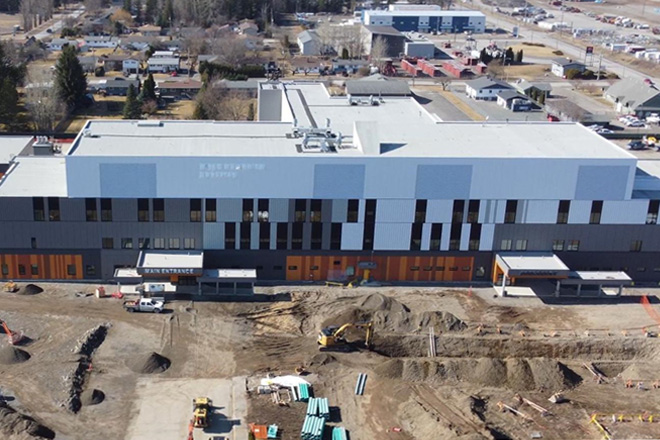Terrace's Mills Memorial Hospital undergoes a sustainable transformation

An upgrade for patients and staff, Mills Memorial Hospital scores high on energy efficiency
The building's bigger. The hallways are wider. There are fewer multiple-person rooms, and way more beds.
The Mills Memorial Hospital replacement in Terrace is the biggest project B.C.'s Northern Health Authority has ever tackled, and it'll transform experiences for both patients and staff. It'll also do so without a huge energy or carbon footprint.
"We're going from 44 to 78 beds, and the building is more than double the size to about 356,500 square feet," says Northern Health communications lead Mark Hendricks. "BC Hydro grants enabled as part of CleanBC's Commercial New Construction Program have really helped. We were able to propose additional energy efficiency and carbon reduction measures."
Per the Government of B.C.'s LEED Gold certification mandate for hospitals in B.C., the new hospital – which may or may not be renamed from Mills Memorial – embraced the idea of taking advantage of what is generally considered waste heat. When the building opens this fall, two heat recovery chillers will serve both HVAC and domestic hot water needs, and enthalpy heat recovery wheels will run 100% all year long without an economizer.
The hospital's highly efficient, low-temperature heating systems are primarily based on recovered heat from building exhaust, or simultaneously rejected cooling load. Only in peak winter conditions will the system be supplemented with high-efficiency, condensing, gas-fired boilers.
Despite a doubling in size, the new hospital will emit fewer greenhouse gases than the old one. Total reduction in greenhouse gases will be at least 40% compared to a similar building without those efficiencies.
"Heat that would normally be coming off that building is going to be recycled back," says Rose St. Pierre, Northern Health's new manager of energy and sustainability.
St. Pierre added that one of the challenges of designing HVAC and other mechanical systems for hospitals is meeting the raised bar for infection control, and for operating 24/7. Another is that hospitals need to be designed for post-disaster operations, and Mills Memorial has a dual-fuel backup system for redundancy.
While PCL Construction was the primary contractor for the project, a lot of the work was sub-contracted to regional contractors including members of the BC Hydro Alliance of Energy Professionals. It was an Alliance firm that performed the new construction energy study under CleanBC's Commercial New Construction Program, which – until a recent Government of B.C. pause on funding the program – offered an up to $15,000 study incentive and capital incentives of up to $625,000 when a Northern region top-up incentive was applied.

New hospital set to improve care and staff retention
The four-storey hospital is an acute care facility that sits alongside another new building – the Seven Sisters Mental Health Residential Facility – that opened in February. The hospital is evolving from Level 4 to Level 3 trauma care, enabling doctors and staff to care for more severe hospitalizations onsite.
There will also be an upgrade in neonatal and pediatric services at the new facility, which will decrease the need for women with more difficult pregnancies to go to larger hospitals in Prince George or Vancouver.
"It's also going to have a massive impact on staff," says Hendricks. "All of health care is having a bit of a crisis right now as far as recruiting people. And one of the things we know is that the new facility is definitely going to be a big draw, both for recruitment and retention."
Hendricks notes that while the size of the building is doubling, the number of beds isn't. A design with wider hallways and more private rooms meets the new higher standard and best practices for hospitals.
Next up for Northern Health are a replacement of Fort St. James' Stuart Lake Hospital, which will almost triple in size, and a new Dawson Creek and District Hospital that will add 27 beds and double the size of its emergency department.
"A lot of learnings from the project in Terrace are being carried over into these projects, and the same standards are being applied, such as moving to single-patient rooms," says Hendricks.


